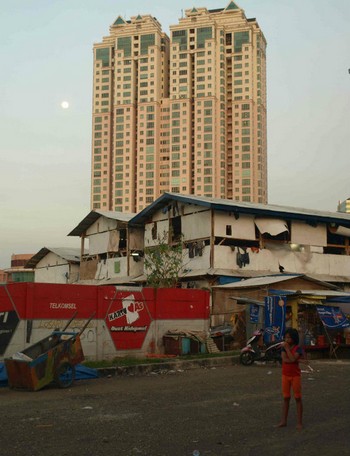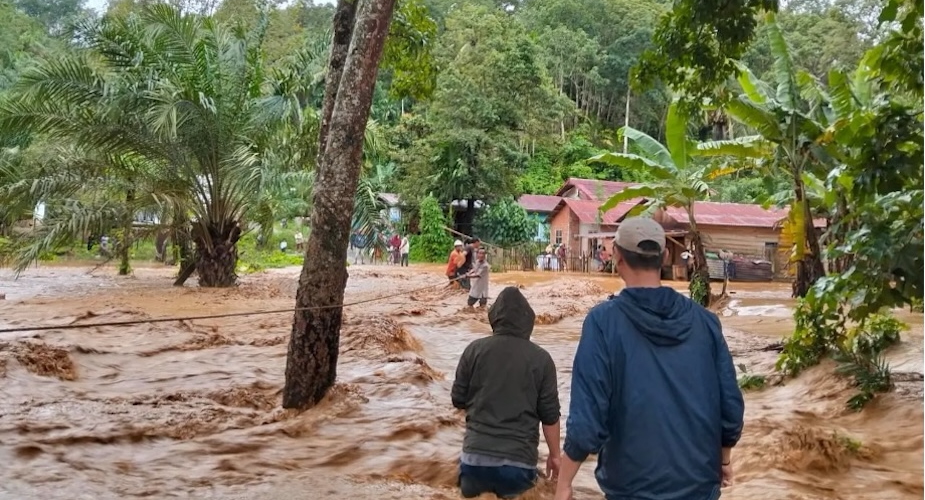How much longer can elites hide their privileges from view?
Christian von Luebke
Indonesia is often touted as Asia’s next success story. Sound macroeconomic policies, resilience to the global financial crisis, and strong consumer markets, are attracting rising attention from foreign investors worldwide. In light of strong economic growth, combined with a youthful demographic profile and stable democracy, a rising number of analysts portray Indonesia as the next Asian tiger in the making.
What usually escapes attention is that economic progress has ‘trickled down’ very unevenly across groups and regions – and often more unevenly than official reports would have us believe. Although Indonesia has embraced democratic and decentralised government, the disparities between socio-economic groups and subnational regions remain substantial. This essay traces the contours of economic inequality from three angles. It explores how accurately current survey measures of economic imbalances might be, how inequalities vary across sectors and space, and how they might affect Indonesian politics.
The inequitable distribution of recent prosperity gains become evident only minutes after stepping out of Sukarno-Hatta International Airport. On the way to Central Jakarta, one can readily observe both ends of the social spectrum: shanty towns flanking the airport highway give way to urban settlements and then high-end shopping malls and five-star hotels.
Statistics
An excursion through Jakarta’s neighbourhoods confirms the impression of social inequality. The plight of street peddlers, who offer songs and small items along traffic-clogged roads, stands in stark contrast to the luxury cars, whose owners occasionally hand out alms through darkly tinted windows. Social gaps appear to be widening – not only in Jakarta, but in many of Indonesia’s towns and districts. The number of Indonesian street children is large and probably growing; one report suggests as many as 230,000 in 2010. Meanwhile, luxury car sales have more than doubled over the last five years; and Indonesia’s top 40 entrepreneurs have built up assets equivalent to nearly one tenth of annual GDP.
Official statistics paint a very different picture, however. Recent economic reviews state that Indonesia’s road to modernisation has been ‘pro-poor’, characterised by relatively low income disparities, declining poverty rates, and steadily improving per-capita incomes. Between 2000 and 2010, the Indonesian economy grew by 5.2 per cent per year, seemingly without inflicting higher levels of inequality. Indeed, the standard measure of economic inequality, the Gini index, has hardly changed in decades. Ranging from zero (perfect equality) to one (all income goes to one household), it has varied only slightly around a moderate level of 0.35 since 1980. At the same time, poverty rates were cut in half and per capita incomes increased three-fold.
Mismatch
While there is no denying that Indonesia has made progress in alleviating poverty, what explains this mismatch between observable and reported inequality levels? Existing reports hide a large part of the income and wealth of top earners. One possible explanation is that government elites, from the Suharto era to the present day, benefit greatly from concealing inequality problems. President Suharto had every incentive to underestimate social imbalances. Official confirmation of pro-poor growth served to legitimise authoritarian rule, reinforce Suharto’s self-styled role as ‘father of development’, and conceal the fact that state elites absorbed a large part of Indonesia’s national income to sustain their patronage networks. Incentives for gauging the true state of inequality remain limited today. Old-regime officials still run the bureaucracy, and patronage still lubricates politics.
Elites benefit greatly from concealing inequality problems
Statistical surveys underestimate social disparities mainly because they partially exclude top incomes. As in many other countries, the Gini index is calculated on the basis of household expenditures. But in Indonesia the national household surveys (Susenas) focus on outdated commodity baskets. They cover basic expenses of rural households, but disregard non-food expenditures common in wealthier urban households. Payments for communication technology, cars, holidays, overseas education, and health care remain unobserved. Moreover, most well-to-do families markedly understate their personal consumption, saving, and investment; or alternatively, evade survey enumerators altogether.
These problems have grown worse. A recent study by Harvard’s Kennedy School of Governance compared Susenas figures with the national accounts data over time. In the early 1970s, Susenas household expenditures were comparable with private expenditures in national accounts. But in the 2008 Susenas round they only cover 35 per cent of them. Not all of these unobserved expenditures fall into high-income brackets, but clearly such imprecision undermines the credibility of current inequality measures.
Labour
The Indonesian government faces several additional challenges on its pathway to pro-poor growth. One is the creation of sustainable job opportunities for low-income families.The economy has expanded rapidly in capital-intensive sectors, whiles labour-intensive sectors have grown slowly. These sectoral imbalances will make Indonesia’s inequality problems worse, at least in the short to medium term.
Economic sectors that require skilled labour and capital investments have experienced substantial growth. Relatively unaffected by the global financial downturn, Indonesia’s financial industry has increased annual earnings by 6.5 per cent between 2008 and 2010. Good results were also reported in other services (6.1 per cent) and trade (5.8 per cent). The most pronounced surge took place in the communications industry : 15 per cent per annum over the last three years. Indonesia’s deregulation policies in 2000 paved the way for a highly competitive telecommunications market and a rapid diffusion of mobile and internet technologies.
Agriculture and manufacturing continue to absorb a large share of the labour force and, for that matter, most of Indonesia’s poor and unskilled workers. Yet manufacturing grew at a disappointing 3.3 per cent between 2008 and 2010, compared to double-digit growth during the Suharto era. Productivity in agriculture and mining grew only 3.9 and 2.8 per cent, respectively, over the last three years. Unless the sectoral growth pattern becomes more balanced, equitable employment and welfare will drift further out of reach.
Regions
Regional imbalances are another challenge.The national motto of ‘unity in diversity’ is a reminder of the vast socio-economic diversity within a unified political system. Fiscal decentralisation after 1998 successfully contained separatist pressure, but it did this by favouring resource-rich provinces and thus accentuating regional imbalances.
Indonesia continues to exhibit pronounced economic disparities across major island groups. In 2009, Papua’s economy grew rapidly by 13 per cent, and Sulawesi’s by 7 per cent, primarily as a result of large-scale investments in cash crop plantations and extractive industries. Other regions, such as Bali, Java, and Sumatra, which are more reliant on trade and tourism, were affected more strongly by the global downturn and recorded low growth rates of between 3 and 5 per cent.
Personal incomes vary strikingly as well. Average incomes in resource-rich regions such as Kalimantan, Sumatra, and Papua are three to four times higher than in resource-poor island groups such as Nusa Tenggara and Maluku. While residents in Kalimantan earn on average seven US dollars per day, their counterparts in Maluku have one and a half dollars at their disposal. These differences are even more pronounced when measured at the district level. The average income in Papua’s best-performing district of Mimika is a staggering 320 times higher than in Papua’s worst-performing district, Tumbraw.
Differences in poverty rates are another aspect of regional inequalities. In Papua, an exceptionally high poverty incidence of 36 per cent coexists with high per capita incomes. This outcome can be explained by Papua’s reliance on capital-intensive, extractive industries (mining, forestry). These have produced few positive spill-over effects for local education and employment. On the other hand, the Balinese economy, which has complemented traditional agriculture with handicrafts and tourism, has cut poverty rates to less than 5 per cent.
 |
|
Official statistics on pro-poor development (1980-2009). They look good on paper, but how real are they? Central Bureau of Statistics |
All in all,while post-Suharto reforms have produced sound economic growth on the national level, they have yet to tackle social and regional inequalities. Income distributions remain more unequal than official reports suggest. If the incomes of top earners were fully accounted for, and estimated along the lines of national accounts rather than of Susenas, the Gini index would rise well above 0.40. This would place inequality levels in Indonesia closer to those observed in China, Malaysia, Thailand, and the Philippines.
Politics
Yet, even if Gini estimates were corrected upwards, parliament would likely not take inequality problems seriously. Patronage politics continue to stack the cards against redistributive measures. An instructive example is the tug-of-war between finance minister Sri Mulyani and Golkar chair Aburizal Bakrie. Mulyani tried to force Bakrie’s companies to settle national tax debts and compensate East Javanese communities for environmental damages. This prompted a series of political confrontations which culminated in Mulyani’s resignation in May last year. Elite resistance has marred Yudhoyono’s second term, exemplified in well-staged attacks against Indonesia’s Corruption Eradication Commission (KPK), Indonesia Corruption Watch (ICW), and Presidential Reform Taskforce (UPK4).
National and regional parliaments should be debating redistributive policies such as the promotion of labour-intensive industries, the introduction of progressive taxes, and the enforcement of minimum health and education standards. But status-quo interests ensure these debates remain muted.
However, inequality discussions are bound to resurface in the run-up to the 2014 elections. Non-state actors – cooperatives, unions, and student groups – are increasingly making use of social media networks to launch collective petitions. These loosely structured groups need to develop coherent programmatic appeals and strategic partnerships. New opportunities for such alignments may come from revised Indonesian election laws. These will likely rule out political parties which obtain less than 5 per cent of the vote. Smaller parties, concerned about losing their parliamentary seats, will be inclined to respond to societal demands and promote economic redistribution. Changing political alignments and digital spaces will increasingly challenge entrenched interests and, over time, empower Indonesia’s youthful society to demand more equitable policies.
Christian von Luebke (cvluebke@stanford.edu) is a DFG research fellow at the Asia-Pacific Research Center, Stanford University.












